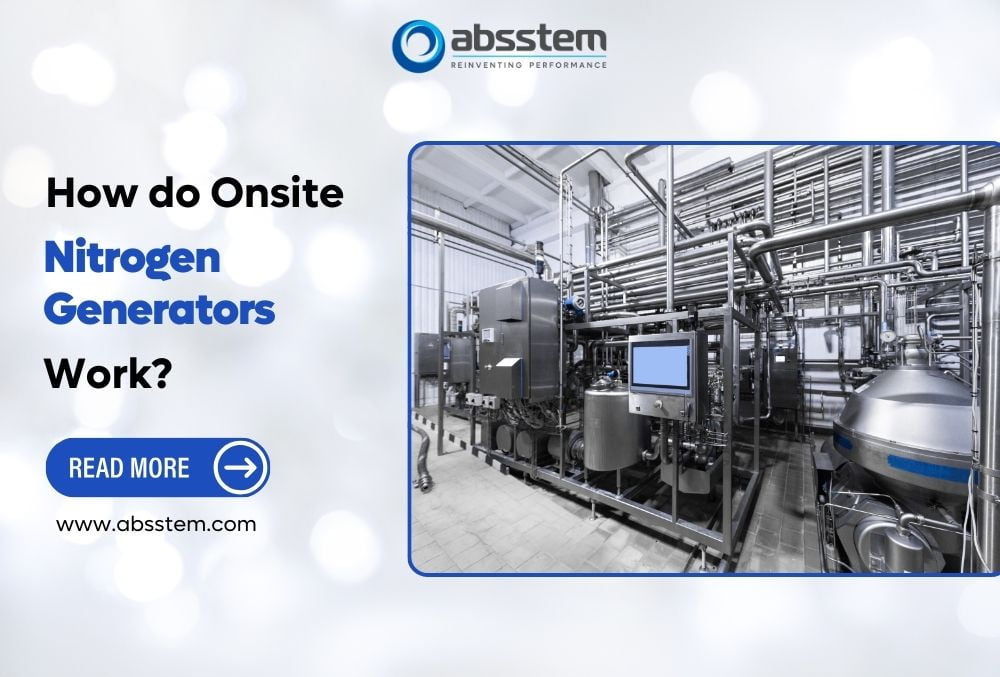Onsite nitrogen generators have emerged as a beacon of efficiency, transforming the way businesses secure a crucial resource. In this exploration, we unravel the intricate workings of these advanced systems, shedding light on the technology that powers the onsite nitrogen generation revolution.
Methods of Nitrogen Production
- Cryogenic Air Separation:
Principle: Cryogenic air separation is a widely utilized method that capitalizes on the differences in boiling points of air components. Air is cooled to extremely low temperatures, causing its components to condense at different points. Nitrogen, having a higher boiling point than oxygen, is separated and collected for industrial use.
Applications: Commonly employed in large-scale operations such as steel manufacturing, chemical production, and medical applications.
- Pressure Swing Adsorption (PSA):
Principle: PSA is a dynamic method where compressed air is passed through adsorbent materials, selectively capturing oxygen and other impurities. Nitrogen, being less adsorbent, passes through, resulting in a purified nitrogen stream.
Applications: Well-suited for smaller-scale applications and industries with moderate purity requirements, including electronics manufacturing and laboratories.
- Membrane Separation:
Principle: Membrane separation relies on semi-permeable membranes to selectively filter out gases based on their molecular size and properties. Nitrogen molecules pass through the membranes, while oxygen and other components are retained, yielding a high-purity nitrogen stream.
Applications: Commonly used in industries requiring nitrogen with medium to high purity levels, such as food packaging, pharmaceuticals, and electronics.
- Chemical Absorption:
Principle: In chemical adsorption, certain absorbent materials react with components of air, selectively absorbing oxygen and other impurities. Nitrogen is then released as the purified gas.
Applications: Less common than other methods, chemical absorption is employed in specialized applications such as gas purification for semiconductor manufacturing.
Ammonia Cracking:
Principle: Ammonia cracking involves the decomposition of ammonia (NH₃) into nitrogen (N₂) and hydrogen (H₂) through a catalytic process. The resulting nitrogen can be collected for industrial use.
Applications: Typically utilized in applications where a mixture of nitrogen and hydrogen is required, such as heat treatment processes in the metallurgical industry.
- Nitrogen Membrane Modules:
Principle: Nitrogen membrane modules use hollow fiber membranes to separate nitrogen from other gases, primarily oxygen. These modules operate on the principle of selective permeation.
Applications: Found in various industries where a compact and reliable nitrogen source is needed, such as laboratories and certain manufacturing processes
Also read – Trends Shaping the Future of Industrial Manufacturing
WHY A GENERATOR INSTEAD OF NITROGEN CYLINDER DELIVERY?
Continuous Supply:
Elimination of Downtime: Onsite nitrogen generators provide a continuous and on-demand supply of nitrogen, eliminating the downtime associated with waiting for cylinder deliveries. This is especially crucial for industries with continuous and uninterrupted production processes.
Cost Efficiency:
Long-Term Savings: Despite the upfront investment, onsite generators often lead to long-term cost savings compared to the recurring expenses associated with cylinder deliveries. Generators reduce or eliminate costs related to transportation, delivery fees, and cylinder rental.
Logistical Challenges:
Transportation and Handling: Cylinder deliveries involve logistical challenges, including transportation, scheduling, and handling. Onsite generators mitigate these challenges by producing nitrogen at the point of use, reducing the need for frequent deliveries and minimizing associated risks.
Space Optimization:
Reduced Storage Space: Nitrogen cylinders require storage space, and businesses often need to manage inventory to ensure an uninterrupted supply. Onsite generators have a more compact footprint and do not necessitate extensive storage space for cylinders, allowing for better space utilization.
Safety Considerations:
Minimized Handling Risks: Handling high-pressure nitrogen cylinders poses safety risks. Onsite generators minimize these risks by reducing the need for manual handling, transportation, and storage of heavy cylinders, contributing to a safer working environment.
Environmental Impact:
Reduced Carbon Footprint: Nitrogen cylinder deliveries contribute to carbon emissions through transportation. Onsite generators align with environmental sustainability goals by minimizing the carbon footprint associated with nitrogen production and delivery.
Operational Flexibility:
Tailored Purity Levels: Onsite generators offer the advantage of adjusting nitrogen purity levels according to specific industrial requirements. This flexibility is particularly valuable for industries with varying purity standards, such as electronics manufacturing and medical applications. Lesser the purity less will be the cost of production of nitrogen.
Scalability:
Adaptable to Changing Needs: Onsite generators are scalable and can be adjusted to accommodate changes in nitrogen demand. This adaptability ensures that the nitrogen supply matches the evolving needs of the business, supporting scalability and growth.
Operational Independence:
Self-Sufficiency: Onsite generators empower businesses to become more self-sufficient in managing their nitrogen needs. This independence from external suppliers and delivery schedules provides greater control over operations.
Convenience and Efficiency:
Streamlined Operations: Onsite generators streamline operations by eliminating the need for coordination, scheduling, and inventory management associated with cylinder deliveries. This convenience contributes to overall operational efficiency.
Conclusion –
As businesses navigate the complexities of their nitrogen requirements, the choice to embrace onsite generators is not just a technological upgrade but a strategic decision for enhanced control, sustainability, and operational excellence. In this era of innovation, onsite nitrogen generators stand as a beacon, pointing towards a future where industries seamlessly meet their nitrogen needs with precision and efficiency.
Related posts:
- The Role of Onsite Oxygen Generators in Brazing
- A Comprehensive Guide to PSA Nitrogen in the Metal Processing Industry
- Save Money by Installing Onsite Nitrogen Gas Generators
- PSA Nitrogen in Chemical Industry: A Comprehensive Guide
- Breathing Easy: Understanding Oxygen Generators and Their Impact on Hospital Efficiency


